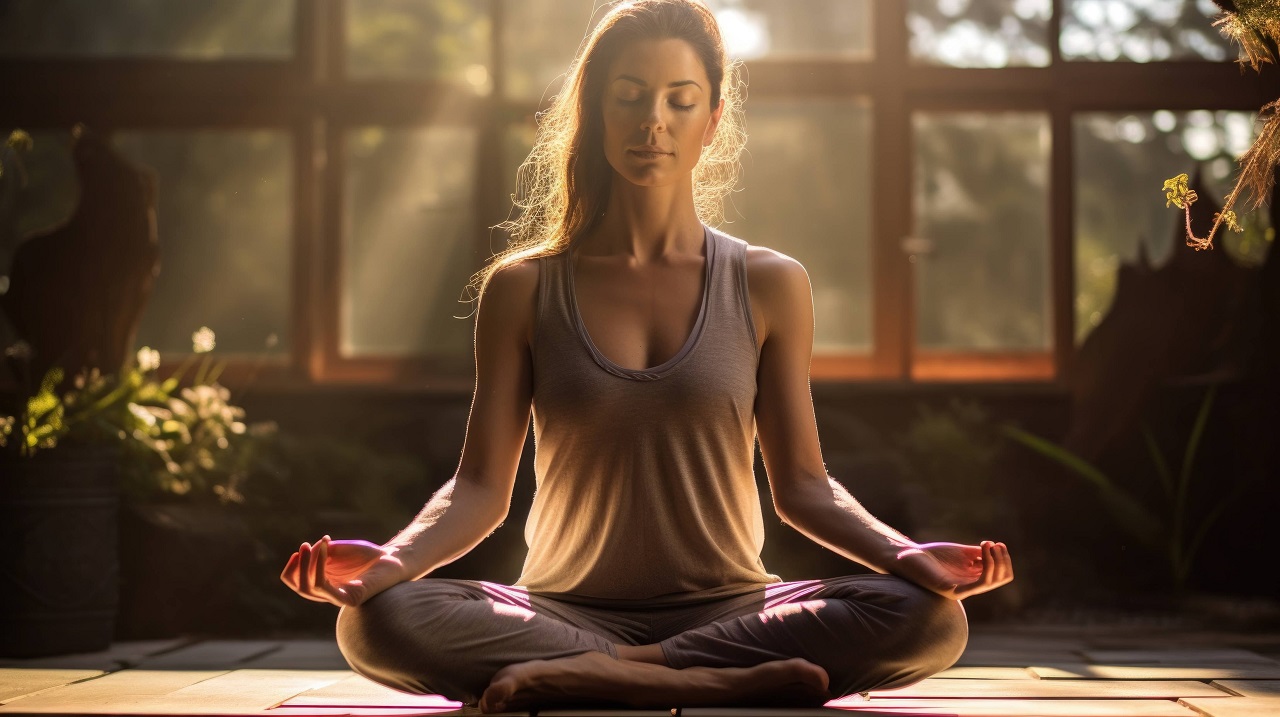
In this article, we will explore the top 10 yoga poses that have been proven to alleviate back pain.
Back pain is a common ailment that affects millions of individuals, and finding effective methods to relieve discomfort is essential.
Through the practice of yoga, one can improve flexibility, strengthen core muscles, and promote proper alignment, all of which contribute to a healthier back.
Whether you are seeking relief from chronic pain or simply looking to maintain a healthy spine, these yoga poses offer a natural and accessible solution.
Downward Facing Dog
The Downward Facing Dog pose is a highly effective compound movement that stretches and strengthens multiple muscle groups in the body, providing relief for individuals suffering from back pain.
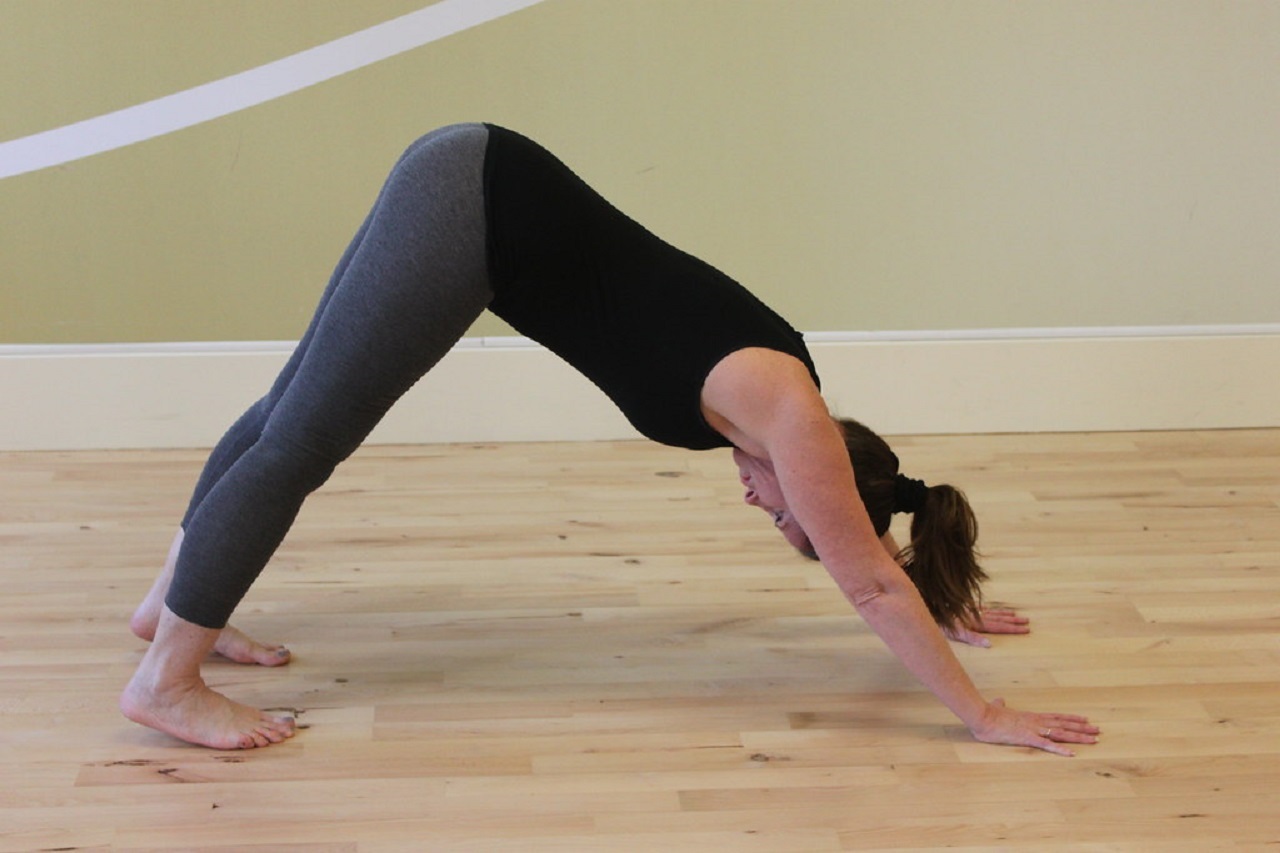
This pose, also known as Adho Mukha Svanasana in Sanskrit, is a staple in yoga practices due to its numerous benefits. It helps lengthen and decompress the spine, relieving any tension or tightness. Additionally, it strengthens the arms, shoulders, and core muscles, improving overall stability and posture.
For individuals with back pain, modifications can be made to make the pose more accessible. They can use props like blocks or a chair to support the hands and maintain proper alignment.
Child's Pose
Occasionally, individuals experiencing back pain can find relief and relaxation through the practice of Child's Pose. Child's Pose, also known as Balasana in Sanskrit, is a gentle and restorative yoga pose that can be highly beneficial for those seeking relief from back pain.

This pose involves sitting on the heels with the knees wide apart and bending forward to rest the torso on the thighs, with the arms stretched out in front or alongside the body. The benefits of Child's Pose include stretching and lengthening the spine, relieving tension in the back, shoulders, and neck, and promoting relaxation and stress relief.
Additionally, Child's Pose can be modified and advanced variations can be practiced by placing a bolster or block under the torso for a deeper stretch or by extending the arms overhead for an added challenge. Advanced practitioners can also incorporate a twist by placing one arm underneath the body and reaching the other arm toward the ceiling. These variations help to further enhance the benefits of Child's Pose and cater to the needs of advanced practitioners.
Cat-Cow Pose
The Cat-Cow Pose is a popular yoga pose known for its ability to alleviate back pain. It is a gentle flowing movement that involves arching and rounding the spine, providing a gentle massage to the back muscles.

Proper alignment is important in this pose to ensure maximum benefits and prevent strain. Beginners can also try variations of the Cat-Cow Pose to gradually build strength and flexibility in the back.
Benefits of Cat-Cow
One of the key benefits associated with practicing Cat-Cow (Cat-Cow Pose) is its ability to improve spinal flexibility and alignment. This pose involves moving the spine through a gentle flowing motion, which helps to stretch and lengthen the back muscles. By practicing Cat-Cow regularly, you can increase the flexibility of your spine and promote better alignment, which can alleviate back pain and improve overall posture.
To ensure proper Cat-Cow form, start on all fours with your hands directly under your shoulders and your knees under your hips. As you inhale, lift your chest and tailbone towards the ceiling, arching your back and dropping your belly towards the floor (Cow Pose). Then, as you exhale, round your spine upwards, tucking your chin towards your chest and drawing your belly button towards your spine (Cat Pose).
The role of breath in Cat-Cow is crucial. As you move through the poses, synchronize your breath with your movements. Inhale as you move into Cow Pose, and exhale as you move into Cat Pose. This coordinated breathing helps to deepen the stretch and relax the mind, promoting a sense of calm and release.
In addition to improving spinal flexibility and alignment, Cat-Cow also helps to strengthen the core muscles, increase circulation in the spine, and massage the organs in the abdominal area. This pose can also help to relieve stress and tension, as it encourages a mindful connection between the body and breath.
Incorporating Cat-Cow into your regular yoga practice can be highly beneficial for alleviating back pain and improving overall spinal health. However, it is important to listen to your body and only go as far as feels comfortable for you. As with any yoga pose, it is always advisable to consult with a qualified yoga instructor if you are new to this practice or have any specific concerns or conditions.
Proper Cat-Cow Alignment
Regularly practicing Cat-Cow pose with proper alignment is essential for reaping its full benefits in alleviating back pain and improving spinal health. Here are three key points to keep in mind when aligning yourself in the Cat-Cow pose:
Spine: Begin in a tabletop position with your hands directly under your shoulders and your knees under your hips. As you move into the Cat pose, arch your back upwards, pulling your belly button towards your spine and tucking your chin towards your chest. In the Cow pose, drop your belly towards the mat, lifting your tailbone and chest upwards while gazing upward.
Breath: Coordinate your breath with your movements in the Cat-Cow pose. Inhale as you transition into the Cow pose, and exhale as you move into the Cat pose. This synchrony of breath and movement enhances the flow of energy and promotes relaxation.
Variations for beginners: If you're just starting out, you can modify the Cat-Cow pose by performing it seated in a chair or with your hands resting on a wall. This provides additional support and stability while still allowing you to experience the benefits of the pose.
Variations for Beginners
If you are new to yoga and looking to incorporate the Cat-Cow pose into your practice, there are several variations that can help you ease into the pose and gradually build strength and flexibility in your back.
These beginner-friendly modifications can be beneficial for those who may have limited mobility or are recovering from back injuries. One variation is to perform the pose while sitting on a chair or using a bolster to support your knees and hands. This can help alleviate pressure on the wrists and knees while still allowing for the gentle stretching of the spine.
Another modification is to perform the pose on all fours, but with a smaller range of motion. This can be achieved by only moving the spine halfway into flexion and extension. By starting with these modifications, you can gradually progress to the full expression of the Cat-Cow pose as you gain strength and flexibility.
It is important to remember that as a beginner, it is common to make certain mistakes in this pose. One common mistake is rounding the lower back too much or collapsing the chest. To avoid this, focus on maintaining a neutral spine and engaging your core muscles throughout the movement. It is also important to avoid straining your neck by keeping it in line with your spine and not dropping the head too low.
With practice and patience, these modifications and avoiding common mistakes will help you safely and effectively incorporate the Cat-Cow pose into your yoga practice.
Bridge Pose

Bridge Pose, also known as Setu Bandhasana, is a highly effective yoga pose that offers numerous benefits for the back. This pose helps to strengthen the muscles of the back, buttocks, and hamstrings, while also stretching the chest and shoulders.
Additionally, there are variations of Bridge Pose that can be practiced to target specific areas of the back and provide additional relief from pain and tension.
Benefits of Bridge Pose
While practicing the Bridge Pose, individuals can experience a range of benefits that contribute to the alleviation of back pain. This pose, also known as Setu Bandhasana, is a gentle yet powerful yoga posture that targets the muscles of the back, hips, and legs.
Here are some of the benefits of practicing the Bridge Pose:
Strengthens the back muscles: Bridge Pose helps to strengthen the muscles of the back, including the erector spinae, which helps to support the spine and alleviate back pain.
Stretches the chest and shoulders: This pose opens up the chest and stretches the shoulders, which can help to improve posture and relieve tension in the upper back.
Improves digestion and circulation: Bridge Pose stimulates the abdominal organs, promoting healthy digestion. It also increases blood flow to the spine, which can help to nourish the discs and relieve back pain.
Variations of Bridge Pose
Several effective variations of Bridge Pose can be incorporated into your yoga practice to further enhance its benefits for alleviating back pain. Bridge Pose modifications offer different levels of challenge and can be tailored to suit individual needs and abilities.
One common variation is the supported Bridge Pose, where a prop such as a block or bolster is placed under the sacrum to provide extra support and comfort. This modification is particularly useful for those with limited flexibility or lower back pain.
Another advanced bridge variation is the One-Legged Bridge Pose, where one leg is lifted towards the ceiling while maintaining the bridge position. This variation helps to strengthen the glutes and hamstrings, providing additional support for the lower back.
Exploring these variations can bring new dimensions to your yoga practice and offer targeted relief for back pain.
Sphinx Pose

The Sphinx Pose, a gentle backbend, can help alleviate back pain and improve spinal flexibility. This pose is accessible for all levels, making it perfect for beginners and seasoned yogis alike. Here are three variations of the Sphinx Pose that can enhance the benefits and cater to individual needs:
Extended Sphinx Pose: In this variation, extend your arms forward and lengthen your spine even more, intensifying the stretch in your back.
Supported Sphinx Pose: Place a bolster or a folded blanket under your forearms to provide support and deepen the opening in your chest and shoulders.
Modified Sphinx Pose: If you have limited flexibility in your lower back, try placing a block or a folded towel under your pelvis to lift it slightly and reduce strain on the lower back.
Remember to listen to your body and make modifications as needed. With regular practice, Sphinx Pose can help alleviate back pain and promote overall spinal health.
Extended Triangle Pose
Extended Triangle Pose, also known as Utthita Trikonasana, is a powerful yoga posture that offers numerous benefits for the back. This pose helps to stretch and strengthen the muscles in the back, promoting better posture and reducing pain.
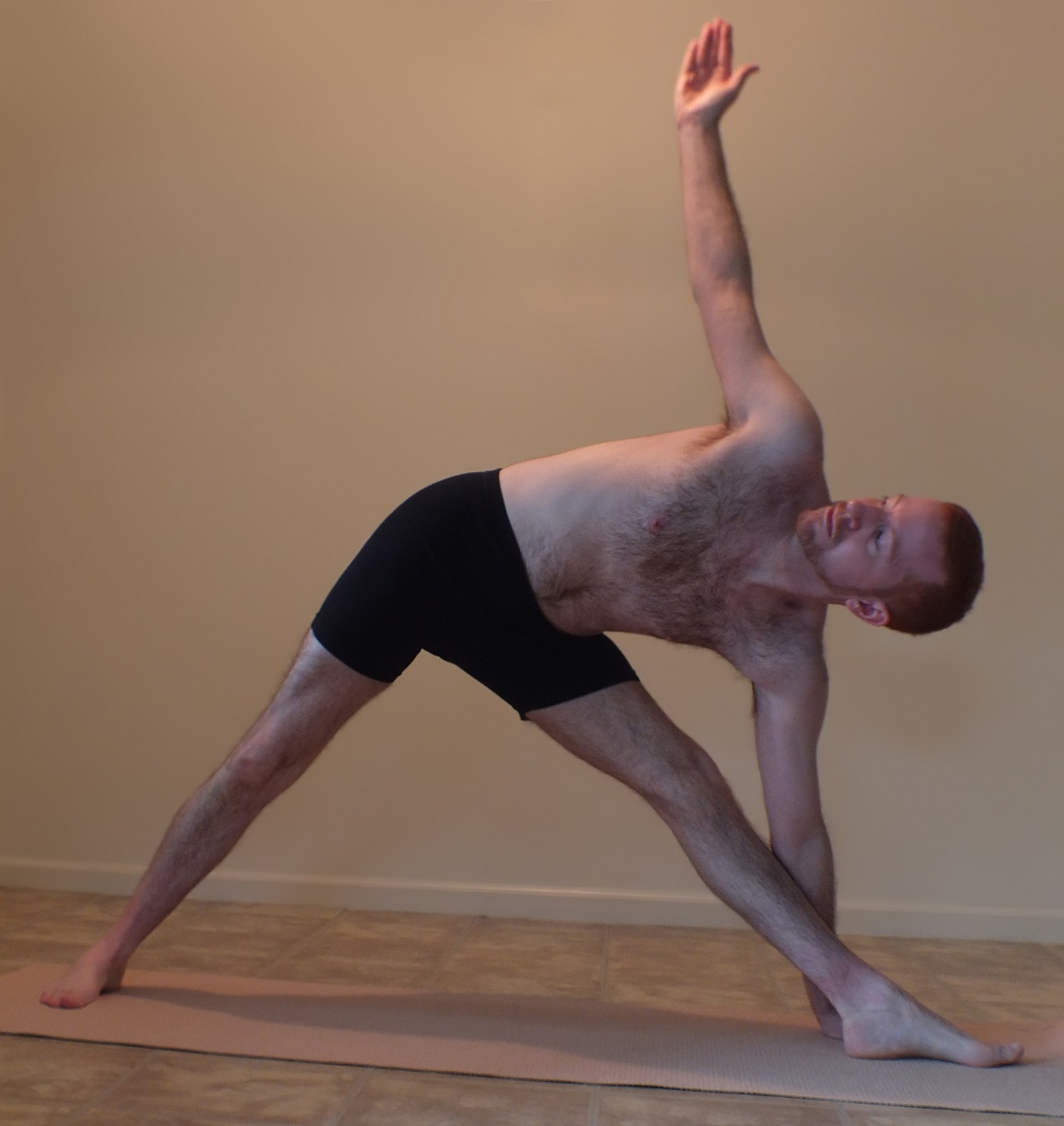
Additionally, there are modifications available for beginners to make the pose more accessible and comfortable.
Triangle Pose Benefits
Significantly, Triangle Pose offers a multitude of benefits for individuals seeking relief from back pain. This powerful yoga pose not only helps to stretch and strengthen the muscles of the back, but it also improves posture and increases flexibility in the spine.
Here are three key benefits of practicing Triangle Pose:
Alleviates back pain: Triangle Pose helps to relieve tension in the lower back by stretching the muscles, reducing stiffness, and increasing blood flow to the area. It can also help to improve spinal alignment and alleviate discomfort caused by poor posture.
Enhances core strength: Engaging the core muscles is essential for maintaining stability in Triangle Pose. Regular practice can strengthen the abdominal muscles, lower back, and obliques, providing support and stability for the spine.
Increases flexibility: Triangle Pose requires a deep stretch through the hamstrings, hips, and side body. This helps to improve overall flexibility, especially in the muscles surrounding the spine. By incorporating modifications and variations such as the Extended Triangle Pose or using props like blocks or a chair, individuals with limited flexibility can still experience the benefits of this pose.
Modifications for Beginners
By incorporating modifications and variations such as using props like blocks or a chair, beginners can gradually ease into the Extended Triangle Pose and experience the benefits of this posture.
The Extended Triangle Pose is an excellent yoga pose for stretching and strengthening the entire body, but it can be challenging for beginners. To modify the pose, beginners can use a block to support their hand on the ground instead of reaching all the way down. This will help maintain proper alignment and prevent strain on the lower back. Additionally, using a chair can provide support and stability for beginners who struggle with balance.
It is important for beginners to focus on proper form and alignment rather than going for a deep stretch. This will help prevent common mistakes in yoga practice, such as rounding the back or overextending the legs. By starting with modifications and gradually building strength and flexibility, beginners can safely and effectively practice the Extended Triangle Pose.
Cobra Pose
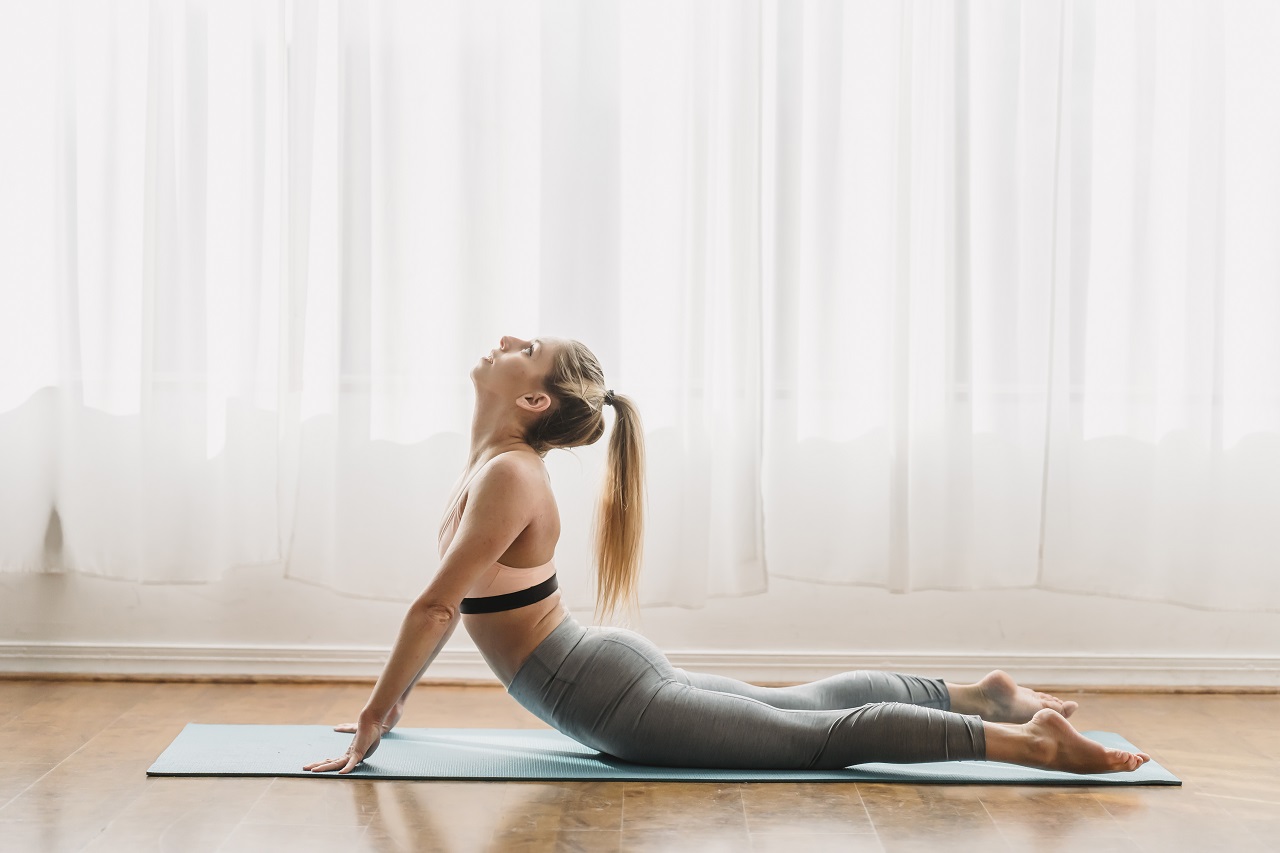
How does practicing the Cobra Pose in yoga help to alleviate back pain? The Cobra Pose, also known as Bhujangasana, is a powerful yoga posture that can provide relief from back pain and offer numerous benefits for the body and mind. Here are three reasons why incorporating the Cobra Pose into your yoga practice can be beneficial:
Spinal flexibility: The Cobra Pose gently stretches the muscles in the back, promoting spinal flexibility and relieving tension in the lower and upper back.
Strengthening the back muscles: By engaging the muscles in the back, including the erector spinae, practicing Cobra Pose helps to strengthen and tone these muscles, providing support to the spine and reducing the risk of future back pain.
Improved posture: Regularly practicing Cobra Pose can help correct poor posture by opening up the chest and shoulders, elongating the spine, and encouraging a more upright posture.
Seated Forward Bend
While providing a gentle stretch to the entire back, the Seated Forward Bend pose in yoga can help alleviate back pain and promote flexibility. This pose is also known as Paschimottanasana in Sanskrit. Seated Forward Bend is an excellent posture for those who spend long hours sitting or have tight hamstrings. It stretches the spine, hamstrings, and calves, while also stimulating the abdominal organs.
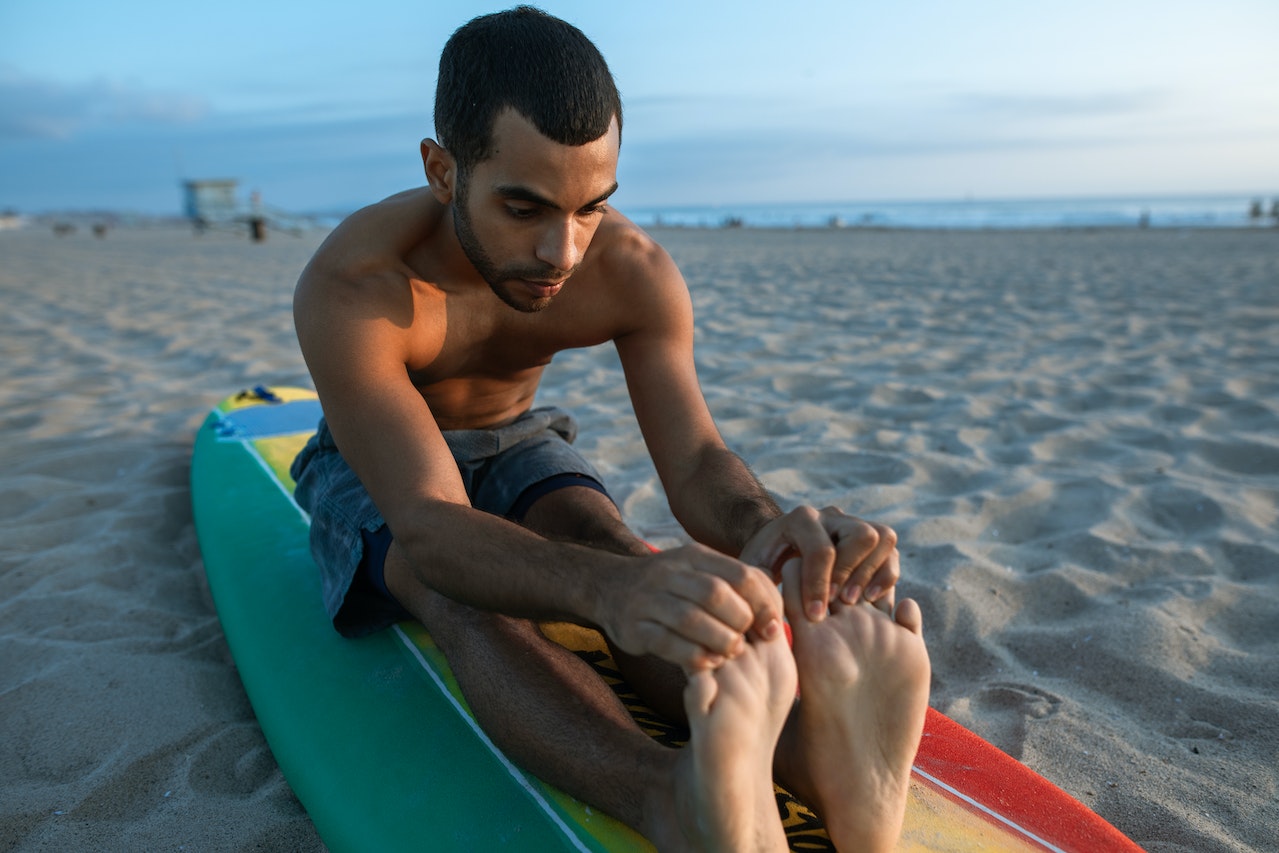
To practice Seated Forward Bend, sit on the floor with your legs extended in front of you. Inhale, lengthen your spine, and as you exhale, slowly hinge forward from the hips, reaching your hands towards your feet. If you are unable to reach your feet, you can use a strap or a yoga block to support your hands.
There are several variations and modifications for Seated Forward Bend. You can bend your knees slightly or keep them straight, depending on your flexibility. Another modification is to use a bolster or folded blanket under your knees to reduce strain on the lower back.
Supine Twist
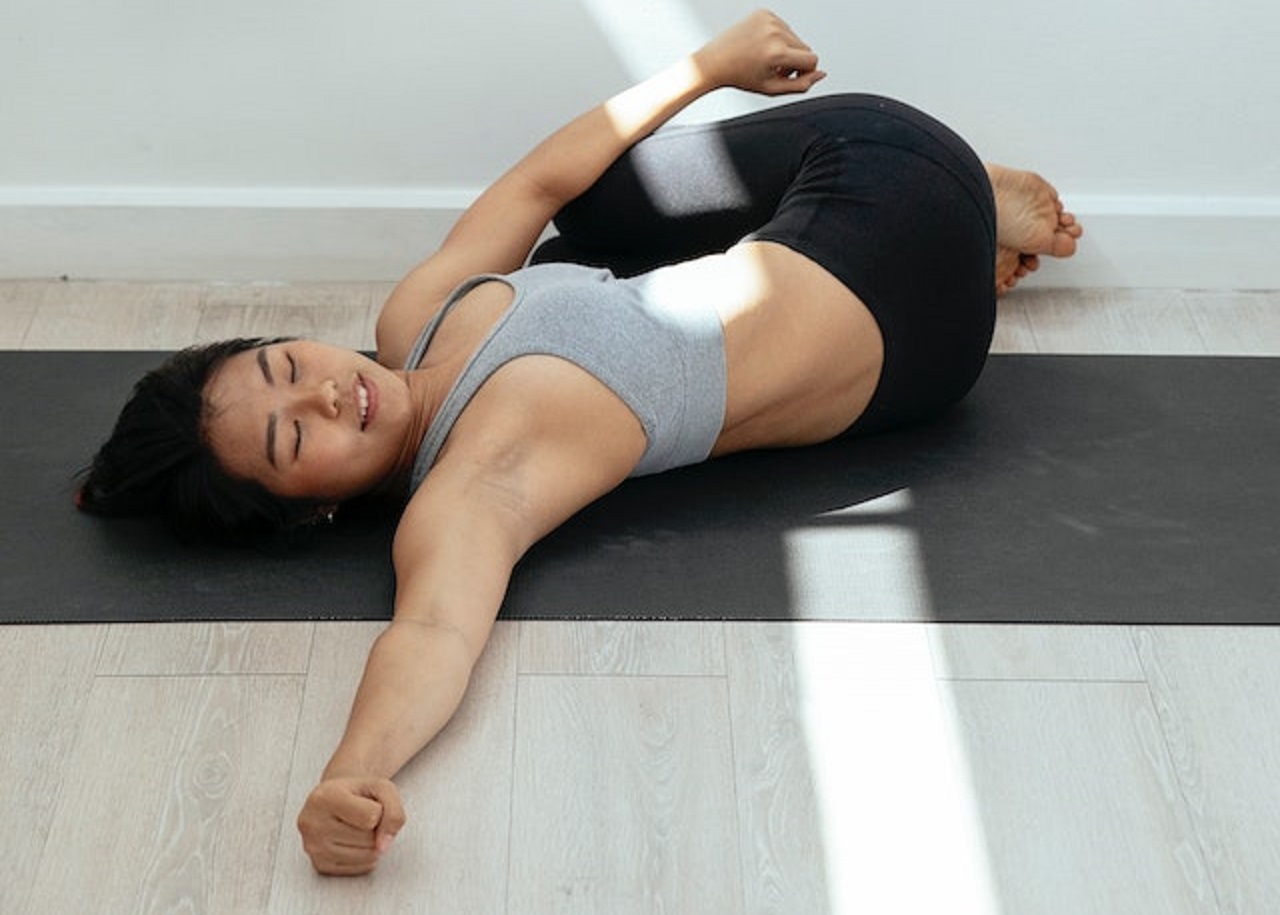
Notably, the Supine Twist pose in yoga offers a gentle yet effective way to alleviate back pain and improve spinal mobility. This pose is often recommended by yoga experts for its ability to release tension in the back muscles and increase flexibility in the spine.
Here are three variations of the Supine Twist that can be modified to suit individual needs:
Knee-Hug Supine Twist: Lie on your back and hug your knees into your chest. Slowly drop both knees to one side while keeping your shoulders grounded. This variation provides a deeper twist and stretches the lower back and hips.
Extended Leg Supine Twist: Extend one leg straight and cross the opposite knee over the extended leg. Gently guide the crossed knee towards the floor on the opposite side. This variation targets the outer hips and provides a gentle twist to the spine.
Supine Twist with a Twist: Place a bolster or folded blanket under your knees to support the lower back. As you twist, reach the opposite arm towards the floor and extend the other arm overhead. This variation adds a stretch to the shoulders and chest while twisting the spine.
Legs Up the Wall Pose
When practicing yoga to alleviate back pain, the Legs Up the Wall pose can provide relief and promote relaxation.
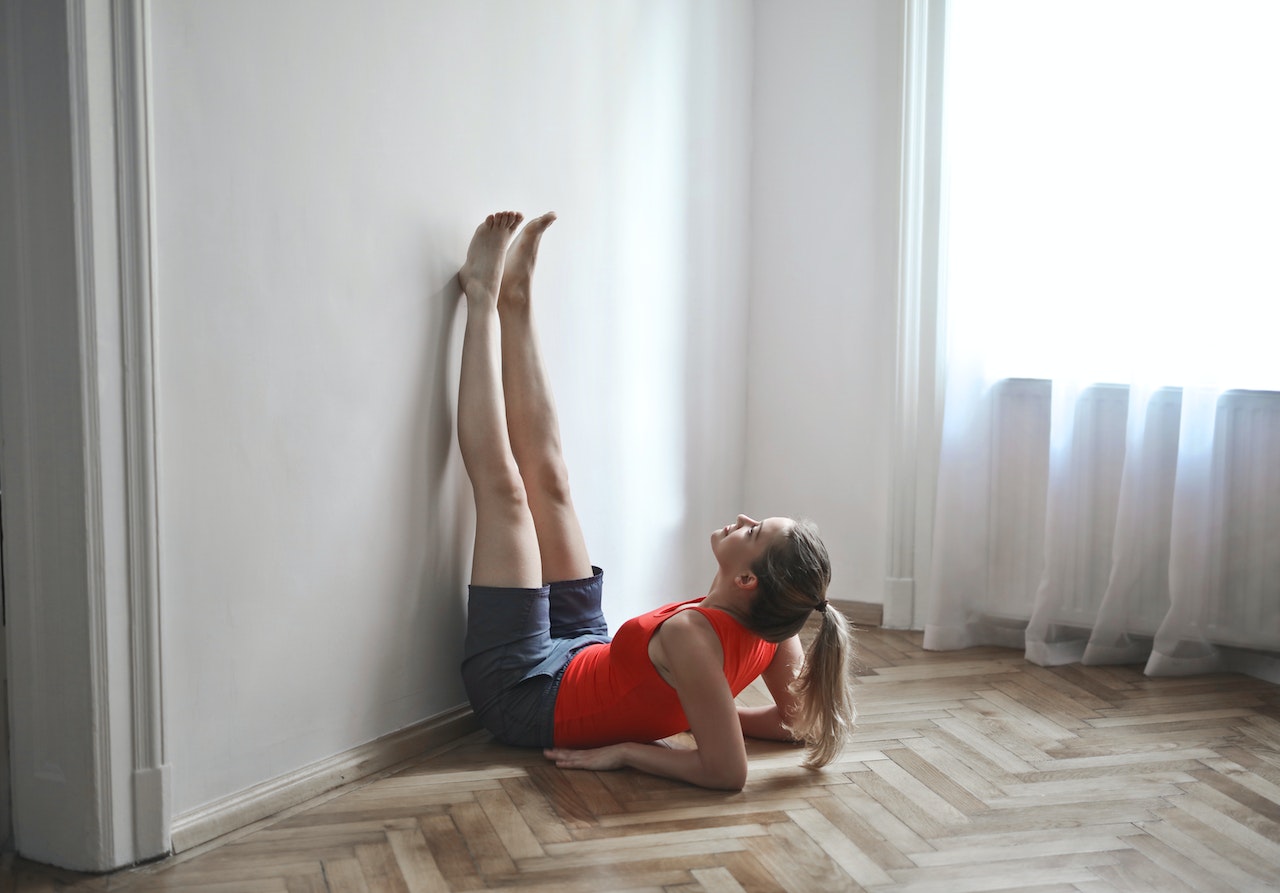
This pose, also known as Viparita Karani, involves lying on your back with your legs extended up against a wall. By elevating the legs, the pose helps to reduce pressure on the spine and lower back, allowing for decompression and gentle stretching of the muscles.
In addition to relieving back pain, the Legs Up the Wall pose offers several other benefits. It can improve blood circulation, reduce swelling in the legs and feet, and promote better sleep.
This pose is particularly helpful for those who spend long hours sitting or standing, as it helps to reverse the effects of gravity and restore balance to the body.
Incorporating the Legs Up the Wall pose into your yoga routine can provide not only relief from back pain but also a sense of relaxation and rejuvenation.
Frequently Asked Questions
How Long Should I Hold Each Pose to Alleviate Back Pain?
For maximum benefit, the duration of holding each yoga pose to alleviate back pain may vary. Beginners are recommended to start with shorter durations, gradually increasing as strength and flexibility improve. Props or aids like blocks or straps can be used to support the back during these poses.
Can Beginners Practice These Poses or Are They More Suitable for Advanced Practitioners?
These yoga poses can be suitable for beginners as well as advanced practitioners. Beginners may need to modify the poses or use props to accommodate their level of flexibility and strength.
Are There Any Modifications or Variations of These Poses That Can Be Done for Individuals With Specific Back Conditions or Injuries?
Modifications for specific back conditions and variations for individuals with lower back injuries can be made in yoga poses. These adaptations ensure safety and cater to the unique needs of practitioners with specific back issues.
Can Practicing These Yoga Poses Alone Completely Eliminate Back Pain, or Should They Be Complemented With Other Treatments or Exercises?
Practicing yoga poses alone may not completely eliminate back pain. It is recommended to complement yoga with other treatments or exercises, such as physical therapy or chiropractic care, to maximize the benefits of yoga for back pain management. Complementary therapies can play a vital role in achieving optimal results.
How Frequently Should These Poses Be Practiced in Order to See Improvement in Back Pain?
The frequency of practicing yoga poses for back pain relief and the duration of holding these poses are important factors to consider in order to see improvement. Consistency and gradual progression are key to achieving desired results.
 Mobility trainingHome Fitness RecoverySports Injury PreventionPersonal Physical TherapyOrthopedic SolutionsPrivacy PolicyTerms And Conditions
Mobility trainingHome Fitness RecoverySports Injury PreventionPersonal Physical TherapyOrthopedic SolutionsPrivacy PolicyTerms And Conditions
